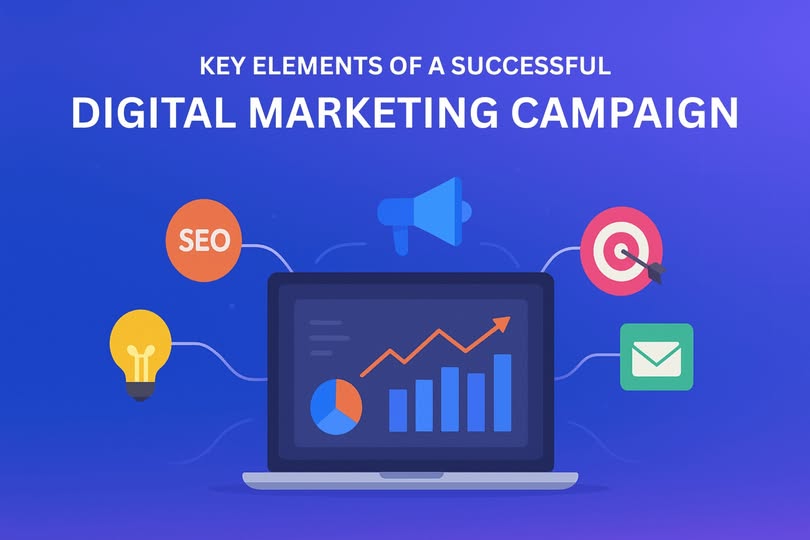
According to HubSpot’s 2024 State of Marketing report, companies that invest in structured digital marketing campaigns generate nearly 3x higher revenue growth compared to those without a defined strategy. In today’s competitive landscape, businesses are no longer asking whether digital marketing matters—they’re asking a more specific question: what makes a marketing campaign successful?
Marketers often look for a clear formula to answer, “what makes a successful campaign?” The truth is, success doesn’t come from a single tactic. It comes from combining several campaign elements—from audience research and content strategy to analytics and optimization—that work together to achieve measurable results.
This blog breaks down the key elements of a successful digital marketing campaign and explains how each one contributes to growth. Whether you’re exploring digital marketing services for the first time or refining your current strategy, understanding these elements will help you build campaigns that not only reach but also engage and convert your audience.
A successful digital marketing campaign is measured by more than just clicks or impressions. True success is tied to clear performance indicators such as return on investment (ROI), lead conversions, engagement rates, and overall business growth. When campaigns consistently deliver measurable results against these metrics, they can be considered effective.
But there’s no single formula that guarantees success. Instead, it’s the combination of several elements of campaign planning and execution—from setting realistic goals to understanding the target audience—that determines outcomes.
Every campaign should start with defined objectives. Without them, measuring success becomes impossible. The most effective way to set goals is through the SMART framework:
When goals are SMART, it’s easier to align marketing efforts with business growth, allocate budgets effectively, and track ROI.
No campaign can succeed without knowing who it’s speaking to. Building data-driven buyer personas helps marketers define the demographics, behaviors, and pain points of their ideal customers. These insights allow for more personalized messaging that resonates with potential buyers.
Audience segmentation plays a major role here. By dividing customers into groups—such as new leads, repeat buyers, or high-value clients—marketers can deliver tailored content and offers that feel relevant instead of generic. This approach not only boosts engagement but also increases the likelihood of conversions.
Every successful campaign is built on a foundation of core elements that guide strategy and execution. These campaign elements work together to attract the right audience, deliver value, and achieve measurable results.
At the heart of any campaign is a clear unique selling proposition (USP)—the reason customers should choose your product or service over competitors. A strong USP highlights benefits, solves a problem, and communicates value in a way that resonates with the target audience.
Consistency is key. The same messaging should flow seamlessly across websites, social media, email campaigns, and ads. When customers see a unified voice and message, it builds trust and reinforces brand credibility.
No single channel can carry the weight of a digital marketing campaign. To maximize reach and impact, marketers need an integrated approach that includes:
A multi-channel strategy ensures campaigns meet potential customers where they are, improving both reach and performance.
Content is the driver behind engagement and conversions. Campaigns that rely on strong storytelling create emotional connections with audiences and encourage action.
A balanced content mix may include:
The right content strategy not only attracts leads but also moves them through the sales funnel with relevant, timely information.
Design influences how people perceive a campaign within seconds. High-quality visuals grab attention, while strong branding creates familiarity and trust.
Every campaign should align with the company’s brand identity—colors, typography, logo, and tone. This consistency helps customers recognize your business instantly and reinforces credibility across different platforms.
Even the best strategy can fail without smart budget planning. Marketers must allocate funds based on campaign goals, target audience, and expected returns. For example, brand awareness campaigns may require more investment in paid ads, while retention campaigns might focus on email marketing.
Efficient budget allocation helps avoid overspending while ensuring each channel delivers the highest possible ROI. Regular tracking allows adjustments when a channel underperforms, keeping the campaign cost-effective.
Even the best-planned digital marketing campaign can fall short without proper tracking and optimization. Success depends on analyzing performance, learning from the data, and making continuous improvements. Tools like Google Analytics, Meta Ads Manager, and other marketing dashboards provide real-time insights into how campaigns are performing across different channels.
By closely monitoring results, marketers can identify what’s working, stop what’s wasting budget, and adjust strategies to maximize ROI.
Tracking the right metrics ensures that campaigns are measured against meaningful business outcomes. Some of the most important include:
Focusing on these metrics provides a clear picture of whether a campaign is truly successful or just creating surface-level engagement.
Optimization is an ongoing process, and A/B testing is one of the most effective methods for improvement. By testing two variations of an element—such as ad copy, landing page design, or call-to-action buttons—marketers can see which version delivers better results.
For example:
The insights gained from these experiments can then be applied across the campaign, ensuring that every dollar spent works harder toward achieving business goals.
Real-world examples often highlight what makes a marketing campaign successful better than theory alone. By looking at well-known campaigns, we can see how different elements of campaign planning and execution come together to drive measurable results.
Nike has consistently used its famous slogan across digital channels, blending motivational messaging with powerful storytelling. Their campaigns feature athletes, everyday users, and social causes—making the brand relatable on a personal level.
Every year, Spotify releases its personalized “Wrapped” playlists, showcasing user data in a fun, shareable format. The campaign thrives on user engagement and viral sharing across social media.
Dove shifted focus from product features to a powerful message about self-confidence and natural beauty. Through social media, video ads, and influencer partnerships, the brand sparked global conversations.
Key Takeaways for Readers:
Conclusion
A recent report from Deloitte found that companies that actively measure and optimize their marketing campaigns achieve 20% higher revenue growth than those that do not. This underscores a simple truth: success in digital marketing doesn’t come from chance—it comes from strategy and execution.
So, what makes a marketing campaign successful? It’s the right mix of well-defined goals, audience understanding, compelling messaging, creative execution, and continuous optimization. When these campaign elements work together, businesses see stronger engagement, higher conversions, and a better return on investment.
If your campaigns aren’t delivering the results you expect, now is the time to act. Start by auditing your current efforts, identifying gaps, and refining the strategies that matter most. And if you need expert guidance, consider partnering with professionals in digital marketing services who can help maximize your performance and scale growth effectively.
